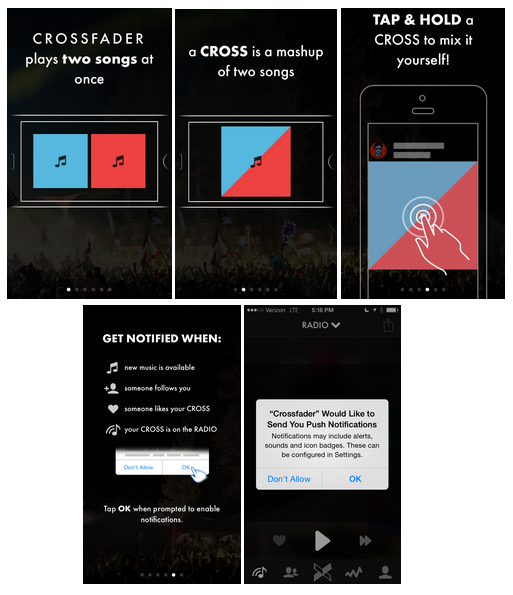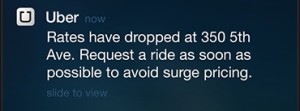New data shows up to 60% of users opt-out of push notifications (Guest Post)
[Andrew: There’s a real shortage of information about push notifications, CTRs, response rates, etc. Partly this is due to the immaturity of mobile as a marketing platform, but it’s also because of the opacity of the iOS platform. I recently ran into Kahuna, a Sequoia-backed startup led by Adam Marchick that’s compiled a treasure trove of data about push notifications. Today, in an article authored by Shannon and Alli of the Kahuna team, they share some of what they know about why people turn off push notifications. You can also hear me talk about this data and how to combat it in the video below.]
Why 60% of your users opt-out of push notifications, and what to do about it
In some product categories, over 60% of their users turn off push notifications. In others, a mere 20% do. That’s a huge difference when we’re talking about the primary method of retaining and engaging your mobile users. Recent data from Kahuna reveals that push opt-in rates vary widely across industries – ride sharing being the best performing, and social being the worst. Here’s a comprehensive look at the state of iOS push opt-in rates, as well as a roadmap for getting back on track if your app is trailing behind.
Here’s the data:

This data shows push enablement rates for iOS devices alone, because Android devices don’t ask users for push permissions. You can see that Ride Sharing’s average opt-in rate (79%) is twice the opt-in rate of Social (39%). This can translate to twice the engagement, revenue and retention, whereas low-performing apps are missing out.
People have an intuitive bias about push. They only want to receive push notifications that are relevant, time-sensitive, and valuable. Our data shows that consumers have innate assumptions about what an app will offer based on the app’s industry. As a result, an app’s ability to bridge the trust gap greatly impacts push enablement rates.
Attractive Industries
Clearly, some apps have an easier time getting push opt-ins than others. The industries with the highest average opt-in rates, specifically Ride Sharing, Food & Beverage (60%) and Financial Services (55%), are those with inherently time sensitive value propositions; users intuitively understand that push notifications will play an important role in the functionality of the app. For example, hearing about the arrival of your ride via push is very important, as is knowing the exact moment your take-out is ready for pickup. These industries benefit from the positive biases around push notifications, because people can see the value of push without much guidance.
Uber’s push notifications convey information that is integral to the functionality of the app and is supposed to be acted upon immediately. Users are able to understand this functionality without much explanation, which contributes to the much higher push enablement rates for Ride Sharing apps.
But What If You’re An Underdog?
If you are in an industry that suffers from low push opt-in rates, can you overcome this inherent user bias? There is a preconceived notion that these kinds of apps only send self-promotional push notifications, and users have a hard time seeing their value upfront. The good news: research shows that you can influence user opt-in rates with comprehensive onboarding strategies. Here are two different techniques to improve the user experience when you ask for push notifications to dramatically increase opt-in rates.
1) Make a Great First Impression
Start off the user’s app experience with a clear and informative splash page, an extra screen that pops up the first time a user opens your app. Use this prime real estate to showcase your app’s top features, and to demonstrate the value of opting into push notifications. When new users fully understand the value of your app and how push messages will add to their experience, they are much more likely to opt-in to push notifications. For example, the Crossfader DJ app launches an interactive tutorial upon first opening the app, explaining the core functionality and the role of push. This educational approach helps Crossfader achieve a 55% push enablement rate, significantly higher than the 44% industry average for News & Media apps.

When Crossfader educates new users about what the app does in a visual and structured way, users feel more compelled to have a dialogue with apps via push. After the core functionality is explained and users know how to use the app, Crossfader outlines exactly how push will add value to the app, and then prompts them to accept push permissions. This strategic approach to asking for push leads to a significantly higher opt-in rate than the industry average.
2) Pop the Question
You have one shot to ask for push permissions; ensure it isn’t wasted by first asking in a pre-ask splash page or in-app message, rather than the official iOS page. By diverting the initial question and gauging the user’s interest, you can save your one opportunity for when the time is right. If the user clicks “YES” in the pre-ask page, prompt them to the official permission page; if the user clicks “NO,” wait until they are more familiar with your app and ask them again later. Cluster utilizes this tactic to achieve a 60% push enablement rate in the social category, with 100% of users opting into push after tapping “Notify Me” in their pre-ask page. By following these best practices, you should be able to improve the user experience and dramatically increase push enablement rates from the industry average.
TechCrunch shows that Cluster has 60% push enablement rate, and during user testing, they saw 100% success rate in iOS push notification permission after tapping “Notify Me.”
If you take a tactful approach to push notifications, you can turn push into a communication channel that users embrace. Make sure you ask for push permissions very carefully to increase your app’s push enablement rate so you can take advantage of push’s full potential.
3) Maintain the Relationship
Once your users begin receiving push notifications, it is critical that you respect this incredibly personal communication channel. By only sending hyper-targeted, personalized push messages that actually add value, you can ensure that your users don’t later opt-out of push, or worse yet, uninstall your app.
There’s no reason your app can’t overcome bias about push notifications. Whether you’re in a high-performing industry like Ride Sharing or Food & Beverage or a low-performing one like News & Media or Social, there is always room for improvement. With a thoughtful, educational and transparent onboarding strategy, you can optimize the user experience and significantly increase your app’s push opt-in rate. Focus on creating and nurturing these important mobile relationships with push notifications to come out on top in the exciting future of mobile. Stay tuned for more data from Kahuna on how users are really responding to push.
PS. Get new updates/analysis on tech and startupsI write a high-quality, weekly newsletter covering what's happening in Silicon Valley, focused on startups, marketing, and mobile.
Views expressed in “content” (including posts, podcasts, videos) linked on this website or posted in social media and other platforms (collectively, “content distribution outlets”) are my own and are not the views of AH Capital Management, L.L.C. (“a16z”) or its respective affiliates. AH Capital Management is an investment adviser registered with the Securities and Exchange Commission. Registration as an investment adviser does not imply any special skill or training. The posts are not directed to any investors or potential investors, and do not constitute an offer to sell -- or a solicitation of an offer to buy -- any securities, and may not be used or relied upon in evaluating the merits of any investment.
The content should not be construed as or relied upon in any manner as investment, legal, tax, or other advice. You should consult your own advisers as to legal, business, tax, and other related matters concerning any investment. Any projections, estimates, forecasts, targets, prospects and/or opinions expressed in these materials are subject to change without notice and may differ or be contrary to opinions expressed by others. Any charts provided here are for informational purposes only, and should not be relied upon when making any investment decision. Certain information contained in here has been obtained from third-party sources. While taken from sources believed to be reliable, I have not independently verified such information and makes no representations about the enduring accuracy of the information or its appropriateness for a given situation. The content speaks only as of the date indicated.
Under no circumstances should any posts or other information provided on this website -- or on associated content distribution outlets -- be construed as an offer soliciting the purchase or sale of any security or interest in any pooled investment vehicle sponsored, discussed, or mentioned by a16z personnel. Nor should it be construed as an offer to provide investment advisory services; an offer to invest in an a16z-managed pooled investment vehicle will be made separately and only by means of the confidential offering documents of the specific pooled investment vehicles -- which should be read in their entirety, and only to those who, among other requirements, meet certain qualifications under federal securities laws. Such investors, defined as accredited investors and qualified purchasers, are generally deemed capable of evaluating the merits and risks of prospective investments and financial matters. There can be no assurances that a16z’s investment objectives will be achieved or investment strategies will be successful. Any investment in a vehicle managed by a16z involves a high degree of risk including the risk that the entire amount invested is lost. Any investments or portfolio companies mentioned, referred to, or described are not representative of all investments in vehicles managed by a16z and there can be no assurance that the investments will be profitable or that other investments made in the future will have similar characteristics or results. A list of investments made by funds managed by a16z is available at https://a16z.com/investments/. Excluded from this list are investments for which the issuer has not provided permission for a16z to disclose publicly as well as unannounced investments in publicly traded digital assets. Past results of Andreessen Horowitz’s investments, pooled investment vehicles, or investment strategies are not necessarily indicative of future results. Please see https://a16z.com/disclosures for additional important information.



